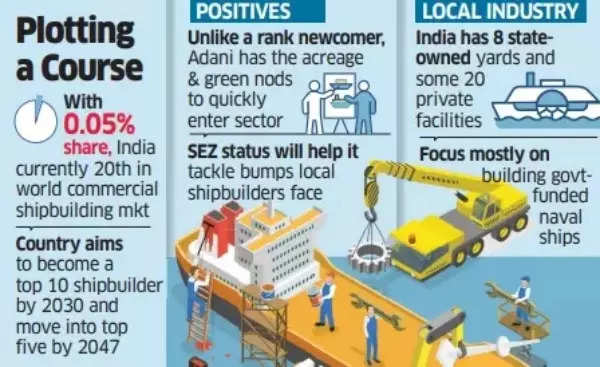According to an ET report, the move aligns with India’s ambitious goal to become a top 10 shipbuilder by 2030, as outlined in the Maritime India Vision 2030, and to further ascend to the top five by 2047, as detailed in the Maritime Amrit Kaal Vision.
Currently, India holds the 20th position in the global commercial shipbuilding market, with a modest share of 0.05%. Ships owned and flagged by India account for approximately 5% of the country’s total overseas cargo-carrying requirements.
Shipbuilding Plans
According to a document prepared by KPMG for a workshop held by the Ministry of Ports, Shipping and Waterways on July 4, India’s potential commercial shipbuilding market up to 2047 is projected to be worth $62 billion.
Adani’s shipbuilding plan is part of the Rs 45,000 crore expansion project for Mundra Port, which recently obtained environmental and coastal regulation zone clearance. The details of this plan were found in the minutes of the Expert Appraisal Committee (EAC) meeting, which is affiliated with the Ministry of Environment, Forest and Climate Change. The committee approved the proposal on May 15.
Also Read | Adani Enterprises to invest $21 billion in its airport business over the next 10 years
Adani, unlike a new entrant, has the advantage of already possessing the necessary land and environmental clearances, allowing the group to quickly enter the heavy engineering sector, which would be its first venture in this field.
The Adani Group’s foray into shipbuilding coincides with the global shipping industry’s gradual shift towards eco-friendly vessels to achieve decarbonization targets.
One estimate suggests that over 50,000 ships need to be constructed in the next 30 years to replace existing fleets.
According to KPMG, the ancillary industry, which includes tier 1, 2, and 3 suppliers, is expected to add $37 billion in value by 2047, potentially creating around 12 million jobs. To achieve the targets set by the Maritime India Vision 2030 and Amrit Kaal Vision, Indian shipyards must increase their annual output from the current 0.072 million gross tonnage (GT) to 0.33 million GT by 2030 and further to 11.31 million GT per year by 2047.
Also Read | Significant milestone! Gautam Adani says Adani Green is now India’s first “das hazari” in renewable energy space
India currently has eight state-owned shipyards and around 20 private facilities, including one operated by Larsen & Toubro Ltd (L&T) at Kattupalli near Chennai. With the exception of Cochin Shipyard Ltd, which is listed on the Mumbai stock exchange and falls under the ministry of ports, shipping, and waterways, the other state-owned yards are managed by the ministry of defence. However, all these yards primarily focus on constructing government-funded naval ships, which is considered a safe and risk-free option compared to commercial ships.
The public sector yards occasionally take on small commercial orders when spare capacity is available and not occupied by naval ship construction. Among the private yards, L&T solely builds defence vessels, having entered the sector during the last shipbuilding boom of 2005-07. However, by the time L&T began operations, the world was already in the midst of the global financial crisis, prompting the company to shift its focus to defence shipbuilding to remain viable.
According to KPMG, the capacity available in shipyards for the construction of commercial vessels is limited, as the industry is primarily oriented towards naval vessels.
